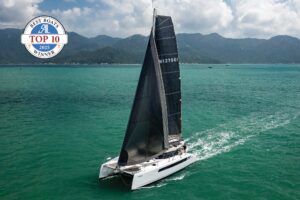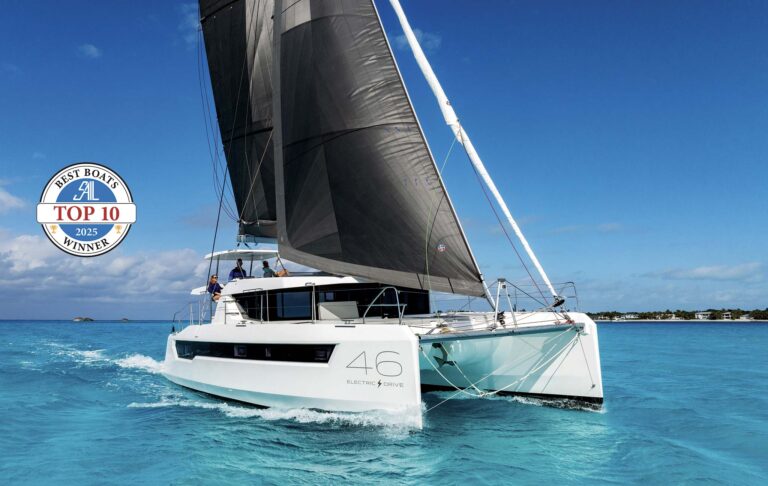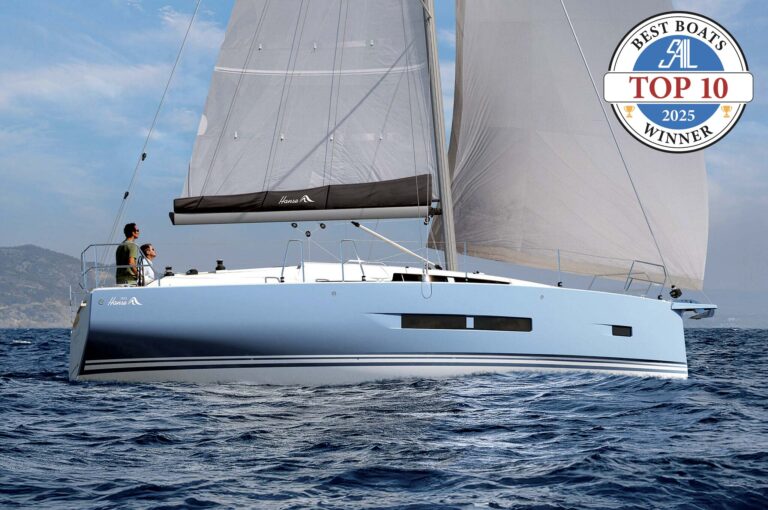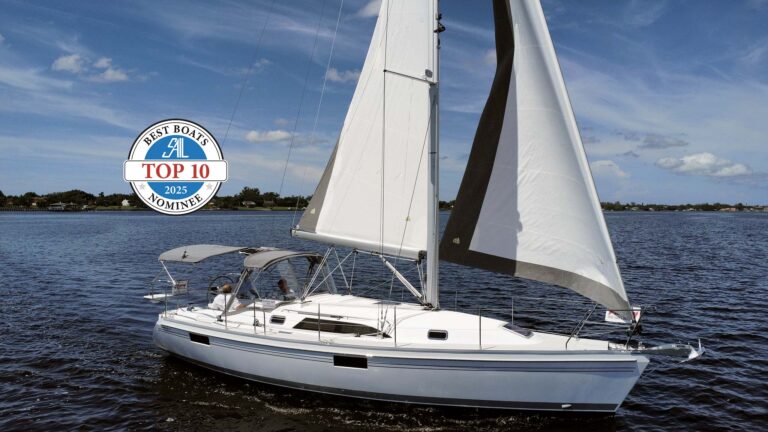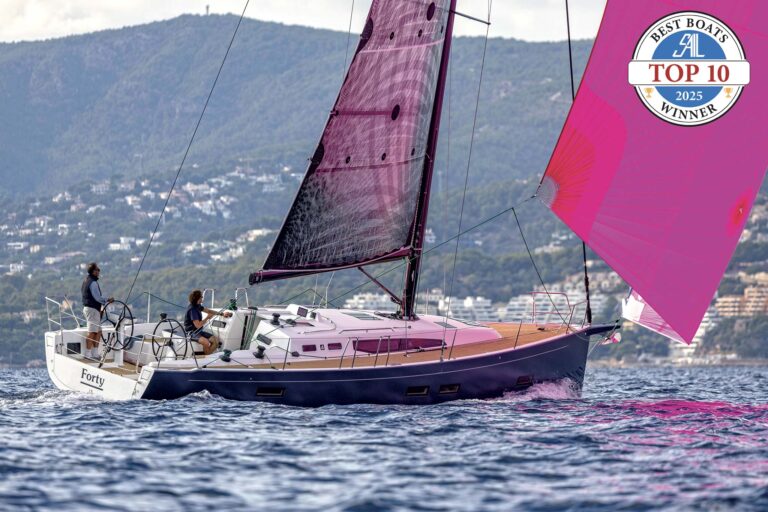
They say good things come in small packages, and the Bavaria Open 40 catamaran is a good example of that. At just 40ft, this cat combines a practical layout with easy sailhandling and a good turn of speed. The result is a boat that is a joy to sail.
Design & Construction
Naval architect Marc Lombard has created a design with high freeboard and narrow hulls with fixed keels, reverse bows and hard chines that run from bow to stern. The latter help part the water and keep the decks dry while also providing a bit of extra interior volume. The boat is fairly light, with solid glass below the waterline and a cored infused laminate above. The Bavaria Open 40’s light-ship displacement is just over 17,000lb, which is about a third less than most other catamarans in this class.
Unlike many cats, the underside of the bridgedeck is not a gullwing shape, but rather a flat section that is high off the water. We did not have the conditions to test whether this shape will pound to weather any more than other catamarans, but it represents an interesting approach.
Nautitech, a formerly French company with 20 years of history, has a reputation for building agile cats that can go the distance. Bavaria recently purchased Nautitech, and the Open 40 is being marketed as the Bavaria Open 40 in the United States. The combination of Nautitech’s multihull expertise and Bavaria’s boatbuilding prowess is a potent one indeed.
On Deck
The most notable aspect of the design is the elongated cockpit, which takes up an almost disproportionate amount of space compared with the compact saloon. However, the cabintop extends all the way aft to the transom, so it provides protection over the entire cockpit, in addition to serving as the attachment point for the mainsheet traveler.
The boat’s twin helms are out on the hulls, making the boat easy to dock and step off of when sailing shorthanded. However, unlike with a mezzanine or full flybridge helm, visibility forward and to the opposite corner of the boat is obscured. Our test boat had its engine controls, electric winch controls and a Garmin MFD display at the starboard helm; optional electronics may be added on the port side. A good autopilot will be key on longer passages in climates that aren’t conducive to spending long hours at the exposed wheels.
Two Lewmar Evo winches help manage the lines at each helm station and integrated steps lead from each wheel up to the deck where handholds along the roof provide good security in a seaway.
The sailplan is simple and reliable, with a VMG aluminum spar and 979ft² of canvas. The self-tacking jib sheets to a track just ahead of the cabinhouse, so singlehanding is easy. For more off-the-wind fun, a gennaker on a continuous-line furler attaches to the bowsprit.

Accommodations
The cockpit is a highlight on most catamarans, but it’s really the star attraction on this model. The dinette table to starboard will seat six to eight people, and there is a straight settee with a section that lifts to form a headrest to port. Yet more bench seating can be found along the aft edge of the cockpit just ahead of the dinghy davits. A sunroof opens overhead for good air circulation, and there are three sizable storage lockers, as well as a dedicated liferaft locker.
A sliding door opens to the saloon, which is necessarily compact given that much of the room usually reserved for this area has been transferred to the cockpit. To port is a combination nav station/dinette, with two small bench seats bookending a table at the head of which is a panel with Garmin electronics. The panel is placed at an awkward angle, but in a world where navigation desks are disappearing altogether, it’s not a bad compromise.
The galley is to starboard and is also pretty compact, though the necessary tools are all there to cook a meal, including twin sinks, an Eno cooktop and two drawers of Frigoboat refrigeration. (A small additional fridge can also be added to the cockpit as an option.) Stowage for provisions and kitchen tools is a bit of an afterthought, but the cook can communicate and hand off meals to the diners in the cockpit via the sliding windows just above the fridges. It’s not a bad sea galley, but it is tight, and the cook will need to dodge any traffic heading up and down to the cabins in the starboard hull.
Visibility in all directions is good, thanks to the wraparound fixed windows and a pair of hatches in the coachroof that bring in yet more light and lots of air. Two layouts are available. The charter version has four cabins and two heads, while the owner version sets aside the entire port hull to serve as a master suite with a head and stall shower forward and a queen-sized berth aft. A small Fischer Panda genset may be fitted as an option in the forward starboard cabin.
For youngsters, there is a small sleeping area in the forepeak of each hull, which can alternatively be used for stowage. The saloon sole is made of Flexiteak synthetic material. Bavaria also offers an upgrade package with wood trim to give the interior a richer feel.
Under Sail
We could not have asked for more perfect conditions during our test sail on Miami’s Biscayne Bay. South of the Rickenbacker Bridge we found a breeze that was hopping while the water of the bay was nearly flat with just a 1ft chop. Our four-person crew had plenty of room to move about, and the boat was in its element. A few tacks under mainsail alone (not an easy maneuver for a catamaran) sent the hulls through the eye of the wind slowly but evenly. Then we put up the small jib, and the fun really started.
At a 130-degree apparent wind angle, with the wind hovering between 16 and 18 knots, we sailed at 7.5 knots. Hardening up, we tacked through 110 degrees and then clicked off 9.1 knots on a beam reach. When the gennaker was unfurled, that same beam reach brought us to just over 10 knots.
Our twin wakes formed rooster tails behind us, and we completely lost track of time, not only because it was a fast sail, but because managing the boat couldn’t have been easier. It’s a pity there was no one around to race.
Under Power
The Bavaria Open 40’s twin optional 29hp Yanmar diesels and saildrives (21hp engines are standard) easily powered us back to the marina at 7 knots. With the throttle wide open at 3,800 rpm we made an impressive 8.1 knots of boatspeed. Fuel capacity is 59 gallons for each engine, giving you a decent range should you ever need to motor through any calms.
Conclusion
Though unconventional, the compact Bavaria Open 40 is practical in its layout, and it works. Being just 40ft long and sporting narrow hulls, there are inevitably some tradeoffs, but Bavaria has done a good job of focusing on a number of key points to create a boat that is all about outdoor living and ease of sailing. If I see one available in charter service, I’ll be sure to claim it as quick as I can for a week of carefree fun.

What do these ratios mean? Visit sailmagazine.com/ratios
- LOA 39ft 4in
- LWL 39ft 2in
- Beam 22ft 7in
- Draft 4ft 5in sail draft 65ft
- Displacement 17,196lb
- Engine 21hp Yanmars with saildrive
- Fuel (GAL) 119
- Water (GAL) 119
- Sail Area 979ft²
- Ratio SA/D RATIO 24 D/L RATIO 128
- Designer Marc Lombard , bavariayachts.com U.S.
- Builder Bavaria Yachtbau, Gieblstadt, Germany
- U.S. Distributor Bavaria USA, Annapolis, MD, 855-222-1120
Get more of SAIL‘s boat reviews here
November 2015


